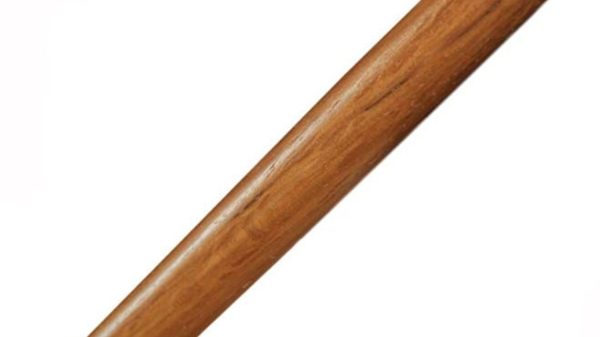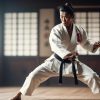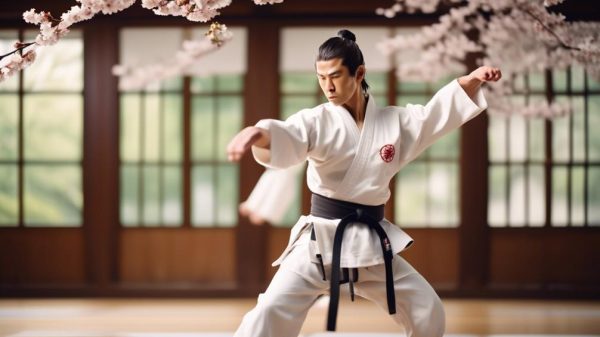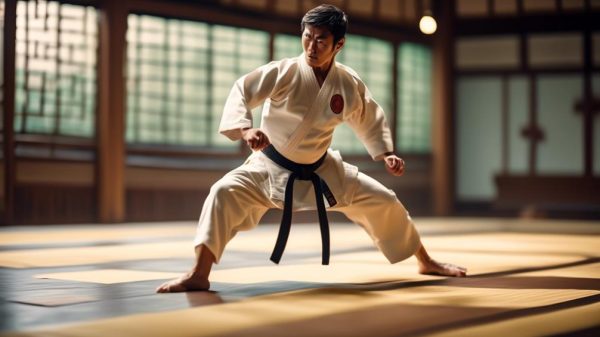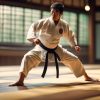The saga of European martial arts unfolds like a silent guardian of the past, whispering tales of valor and skill across the centuries. From the battlefields of antiquity to the refined duels of the Renaissance, each era leaves its mark on the intricate tapestry of combat traditions. As one explores further into the annals of history, they will uncover the hidden gems of forgotten techniques and the untold stories of legendary warriors, painting a vivid picture of a world where honor and mastery walk hand in hand.
Ancient European Martial Arts
Ancient European martial arts, dating back to the Bronze Age, showcase early combat techniques influenced by the use of weapons such as swords, spears, axes, and shields. During the Bronze Age, Europeans honed their skills in sword fighting, developing techniques that laid the foundation for future martial arts practices. The utilization of weapons like swords, spears, axes, and shields not only shaped individual combat styles but also influenced the formation of phalanxes, strategic military formations that were integral to ancient European warfare.
As the Iron Age dawned, Europeans continued to refine their sword fighting techniques, with the xiphos sword becoming prominent and setting the stage for the Roman spatha sword techniques that would follow. The survival of weapons from the Bronze Age provides modern historians with valuable insights into the parrying techniques and offensive maneuvers employed by ancient European warriors. Additionally, the emphasis on spears and shields in formations like phalanxes highlights the strategic and collective nature of combat during this era.
Studying ancient European martial arts offers a glimpse into the evolution of combat tactics and weaponry that shaped the martial traditions of the continent. By delving into the practices of our ancestors, martial arts enthusiasts can gain a deeper appreciation for the rich history and cultural heritage that underpin European martial arts today.
The Influence of Ancient Greece and Rome on European Martial Arts
Drawing on the rich combat traditions of Greece and Rome, European martial arts have been deeply influenced by the grappling and striking techniques of ancient Greek wrestling and boxing, as well as the diverse fighting styles showcased in Roman gladiatorial combat.
Ancient Greece, known for its emphasis on physical prowess and combat sports, laid the groundwork for European martial arts by highlighting the importance of grappling and striking techniques in hand-to-hand combat. Greek wrestling, with its focus on throws, locks, and pins, provided a foundation for later European wrestling styles, influencing the development of grappling techniques in various regions. Similarly, Greek boxing, which emphasized agility, speed, and precise striking, contributed to the evolution of striking techniques in European martial arts.
On the other hand, ancient Rome's gladiatorial combat introduced a wide array of fighting styles and weapons, shaping the combat philosophies of European martial arts. The spectacle of Roman gladiators engaging in combat with different weapons and techniques captivated audiences and inspired European practitioners to explore a diverse range of fighting methods.
The legacy of ancient Greece and Rome lives on in European martial arts, where practitioners continue to study and adapt these ancient combat traditions to modern training methods, ensuring that the essence of grappling, striking, and diverse fighting styles endures in contemporary European martial arts practices.
Medieval European Martial Arts
Medieval European martial arts, heavily influenced by the feudal system, placed a strong emphasis on developing combat skills tailored for knights and nobility. Techniques in medieval martial arts revolved around swordsmanship, mounted combat, wrestling, and spear fighting. Combat manuals, such as the 'Fiore dei Liberi' manuscripts, provided detailed instructions on these arts, offering insights into the intricate techniques and strategies employed during that era.
The history of martial arts during the medieval period saw significant evolution with the introduction of plate armor. This advancement had a profound impact on fighting styles and techniques, necessitating adaptations to overcome the defensive capabilities of such armor. Guilds and schools dedicated to teaching these martial arts emerged, emphasizing values such as honor, chivalry, and battlefield tactics among aspiring warriors.
Medieval European martial arts exemplify a time when combat prowess was intricately tied to social status and honor. The legacy of these martial arts continues to be preserved through historical records, combat manuals, and modern interpretations, offering a glimpse into the sophisticated and disciplined training methods employed by knights and nobles of the past.
The Role of Knighthood and Chivalry in Medieval Martial Arts
Knighthood and chivalry in medieval martial arts were foundational principles that underscored the code of conduct and combat training for European nobility. Emphasizing virtues such as honor, bravery, and loyalty, knights weren't only trained in combat skills like swordsmanship, horsemanship, and jousting but also in upholding the ideals of chivalry. Chivalric codes governed their behavior in battle, advocating for fair play, protection of the weak, and respect for opponents. These principles influenced the development of knightly tournaments, where martial skills were displayed and tested in a controlled setting.
The training of knights in medieval martial arts seamlessly integrated physical prowess with moral values to uphold chivalric ideals in both warfare and society. Knights weren't only skilled warriors but also exemplars of virtue, embodying the essence of chivalry in their actions on and off the battlefield. The combination of martial prowess and noble conduct set knights apart as paragons of virtue in medieval Europe, shaping the cultural landscape and leaving a lasting legacy that continues to resonate in the modern world.
Renaissance Era Martial Arts
The Renaissance era marked a significant evolution in European martial arts, with notable Masters systematizing Western fighting skills into sophisticated techniques, introducing the rapier as a weapon for street-fighting and dueling. Masters like Camillo Agrippa and Girard Thibault played vital roles in shaping Renaissance martial arts. These Masters not only refined combat techniques but also integrated elements of geometry, mathematics, anatomy, and philosophy into their teachings, elevating martial arts to a new level of sophistication. The rapier, a slender, pointed sword, became the focus of Renaissance martial arts, emphasizing its use in urban self-defense scenarios and dueling situations.
During the Renaissance era, Masters of Defence produced detailed manuals outlining systematic European martial arts techniques. These manuals served as guides for practitioners, offering insights into various fighting methods and strategies. The emphasis on precision and skillful execution was paramount in Renaissance martial arts, laying the foundation for the development of fencing as a structured combat sport. The legacy of these Renaissance Masters continues to influence modern European martial arts, showcasing the enduring impact of their contributions to the evolution of combat techniques and strategies.
The Impact of the Renaissance on European Martial Arts
During the Renaissance, European martial arts underwent a transformation influenced by the integration of geometry, mathematics, anatomy, and philosophy into combat techniques by renowned Masters like Pietro Monte and Camillo Agrippa. This period marked a significant shift in the systematization of Western fighting skills, with the introduction of sophisticated Western fighting techniques. One of the most iconic weapons developed during this time was the rapier, specifically designed for street-fighting and dueling purposes. The rapier became the first civilian weapon, tailored for urban self-defense needs, reflecting the changing nature of combat in Renaissance Europe.
Masters such as Pietro Monte and Camillo Agrippa revolutionized martial arts by incorporating these intellectual disciplines into their teachings, elevating combat techniques to new levels of complexity and effectiveness. The emphasis on geometry and mathematics brought precision and strategy to swordplay, while insights from anatomy improved understanding of human kinetics, enhancing the efficiency of movements in combat. Moreover, the infusion of philosophical principles added depth to martial arts training, emphasizing not only physical prowess but also mental discipline and ethical conduct in combat situations.
Historical European Martial Arts (HEMA)
With the Renaissance influencing the systematization of Western fighting skills, Historical European Martial Arts (HEMA) emerged as a discipline based on technical treatises from the Late Middle Ages to the early modern period. HEMA encompasses a wide array of sword-based techniques, including the longsword, rapier, and British military sabres. Practitioners of HEMA place a strong emphasis on historical accuracy, meticulously studying and replicating techniques from centuries-old manuals to guarantee authenticity in their practice.
In the global HEMA community, tournaments play a significant role in allowing practitioners to test their skills against others and showcase their proficiency in historical sword-fighting techniques. These events not only serve as platforms for friendly competition but also as opportunities for practitioners to learn from one another and deepen their understanding of European martial arts.
Through the dedication of HEMA practitioners worldwide, the discipline has experienced a resurgence in popularity, attracting individuals keen to explore the knightly art of medieval sword fighting. The global community of HEMA enthusiasts continues to grow, united by a passion for historical European martial arts and a commitment to upholding the traditions of the past.
Notable HEMA Masters and Their Contributions
Johannes Liechtenauer, a pivotal figure in late medieval martial arts, revolutionized the German school of fencing with his codified techniques and principles. Liechtenauer's contributions to Historical European Martial Arts (HEMA) are significant, as he developed a thorough system of fencing that emphasized strategic thinking, precise movements, and practical application in combat. His teachings were documented in fencing manuals that detailed various fencing techniques, footwork patterns, and principles of combat. These manuals served as essential resources for future generations of martial artists, providing valuable insights into the art of swordsmanship.
Fiore dei Liberi, an Italian master of the 14th century, made significant contributions to HEMA with his fencing manual 'Fior di Battaglia'. This manual not only showcased a wide array of combat techniques but also highlighted strategic approaches to combat and the importance of adaptability in different fighting scenarios. Achille Marozzo, an Italian fencing master from the 16th century, further expanded on the teachings of HEMA with his work 'Opera Nova', which presented a detailed system of swordsmanship and wrestling techniques.
George Silver, an English fencing master of the Elizabethan era, advocated for the use of the English backsword and promoted his martial philosophy in his works. Joachim Meyer, a German master of the late 16th century, compiled the 'Gründtliche Beschreibung der Kunst des Fechtens', encompassing various weapons and techniques in his fencing system. These notable masters have left a lasting impact on HEMA, shaping the development of fencing techniques and principles that continue to be studied and practiced by martial artists today.
The Influence of HEMA on Modern European Martial Arts
The impact of Historical European Martial Arts (HEMA) on modern European martial arts is profound, shaping the evolution of combat techniques and training methods. HEMA, focusing on the period from ca. 1300 to 1800, plays a significant role in the resurgence of traditional stick-fighting methods and various Western martial arts disciplines. Modern European martial arts heavily draw from HEMA, incorporating sword-based skills and historical fencing sub-styles with an emphasis on historical accuracy in techniques and equipment. Participation in HEMA communities has led to a global resurgence in studying Medieval, Renaissance, and 19th-century martial arts masters.
The influence of HEMA on modern European martial arts can be seen in the meticulous reconstruction of historical combat techniques within HEMA, which has shaped the practices of contemporary martial artists. This influence extends to the revival of traditional stick-fighting methods and the incorporation of historical fencing sub-styles in modern European martial arts. The emphasis on historical accuracy in techniques and equipment within HEMA hasn't only preserved ancient combat traditions but also enriched the training methods of practitioners of modern European martial arts. The global resurgence in studying Medieval, Renaissance, and 19th-century martial arts masters is a reflection of the enduring impact of HEMA on the evolution of combat arts in Europe.
Traditional European Wrestling Styles
European wrestling traditions encompass a rich history that dates back to ancient times, with techniques emphasizing grappling and throws for strategic control over opponents. Traditional European wrestling styles, such as Greco-Roman wrestling and Celtic wrestling, have deep-rooted origins, influencing various modern grappling arts and combat sports worldwide. Greco-Roman wrestling, with its focus on upper body throws and groundwork without holds below the waist, has been a prominent style practiced for centuries. Celtic wrestling, on the other hand, emphasizes the use of jackets and belts for grappling techniques, reflecting the unique cultural influences of the Celtic regions.
Furthermore, regional wrestling styles developed across different parts of Europe, each carrying its own set of techniques and rules. These regional variations highlight the diverse combat needs and traditions of European societies. These styles often served as not only sporting contests but also as essential components of military training, emphasizing practical techniques for close combat scenarios. The preservation of traditional European wrestling continues to this day, with practitioners dedicated to upholding ancient techniques and skills passed down through generations, ensuring that these historical martial arts remain alive and relevant in the modern world.
Greco-Roman Wrestling
Greco-Roman wrestling, originating in ancient Greece and Rome, is a style of wrestling that emphasizes upper body techniques such as throws, locks, and holds while forbidding leg attacks. This ancient sport, with roots dating back to the 8th century B.C., showcases the art of using strength and technique to overpower opponents without the use of leg maneuvers. Greco-Roman wrestling, recognized as an Olympic sport since 1896, highlights the enduring tradition of combat sports in modern competitions.
Competitors in Greco-Roman wrestling aim to score points by executing well-executed throws and securing their opponent's shoulders to the mat. This emphasis on upper body techniques distinguishes it from other wrestling styles, requiring athletes to master the art of controlling and manipulating their adversary using grips, throws, and locks. The sport's focus on pinning techniques underscores the significance of strategic positioning and physical prowess in achieving victory.
Greco-Roman wrestling remains a prominent discipline in modern combat sports, attracting athletes who appreciate the technical precision and physical strength required to excel in this ancient art. Its inclusion in the Olympic Games further solidifies its status as a prestigious and enduring aspect of European martial arts, preserving the legacy of ancient combat traditions for contemporary audiences.
Celtic Wrestling
How did Celtic Wrestling, known as 'Glima,' establish itself as a prominent Scandinavian martial art? Celtic Wrestling, or Glima, holds deep roots in Norse mythology and Viking traditions, making it a significant part of Scandinavian martial heritage. This ancient form of combat focuses on throws, takedowns, and ground grappling techniques, placing emphasis on balance, agility, and leverage. Practiced for centuries in Scandinavia, Glima serves both as a method of combat training and a competitive sport.
Glima competitions are a showcase of skill and strength, where opponents don special belts to aid in grips and throws. The historical importance of Celtic Wrestling in Scandinavian societies can't be understated. Passed down through generations, this martial art preserves unique techniques and cultural heritage, reflecting the warrior spirit of the Nordic people.
With its origins intertwined with Viking culture and mythology, Glima stands as a tribute to the combat prowess and physical abilities of the Scandinavian warriors. The tradition of Celtic Wrestling continues to thrive in modern times, keeping alive the legacy of ancient martial arts practices in the region.
Regional Variations in European Wrestling
Celtic Wrestling, known as Glima, is just one example of the diverse regional variations in European wrestling traditions, each with unique techniques and cultural influences. German Ringen, dating back to the Middle Ages, is a prominent style that emphasizes grappling, throws, and joint locks, shaping the development of later European wrestling techniques.
Scottish Backhold wrestling, prevalent in Highland Games and local competitions, focuses on standing grappling with a distinct backhold grip, showcasing the Scottish heritage in wrestling. French Lutte Bretonne, originating from Brittany, highlights techniques such as trips, throws, and holds, with a historical background deeply rooted in regional competitions. These regional variations in European wrestling not only demonstrate cultural differences but also reflect the historical influences that have shaped these distinct styles for combat and sport.
The evolution of European wrestling traditions has been enriched by these regional variations, each contributing to the diverse tapestry of martial arts across the continent. From the technical finesse of German Ringen to the traditional charm of Scottish Backhold and the competitive spirit of French Lutte Bretonne, European wrestling continues to captivate practitioners and enthusiasts alike with its rich history and unique techniques.
The Evolution of European Fencing
The evolution of European fencing techniques traces back to the 16th century in Germany and Italy, where notable figures like Agocchie, Sainct-Didier, and Viggiani made significant contributions during the Renaissance and Baroque periods. Italian fencing and German fencing gained popularity during this time, influencing fencing techniques across Europe. The 16th century marked a pivotal period for fencing evolution, with the development of treatises and the refinement of swordsmanship techniques.
Italian fencing, characterized by its emphasis on speed and precision, played a key role in shaping European fencing styles. The Italian School of fencing, with its focus on the rapier, introduced intricate footwork, blade work, and strategic movements that set the foundation for modern fencing. French fencing, known for its elegance and grace, also made significant contributions to the evolution of European fencing, particularly in the development of foil and epee techniques.
As fencing evolved from traditional methods to modern sports fencing in the 19th century, the refinement of techniques led to the transformation of fencing into a purely competitive sport. The legacy of Italian and French fencing schools continues to influence contemporary fencing styles, as the traditional martial arts revival in European fencing preserves historical techniques while adapting them to modern sports contexts.
Italian School of Fencing
During the 16th century, the Italian School of Fencing stood out for its remarkable versatility in swordsmanship techniques. Italian rapier fencing and German fencing gained considerable popularity during this period, with Italian fencing guards and techniques exerting a widespread influence across Europe. The Italian School of Fencing became the Western European standard for fencing techniques, contributing significantly to the development and refinement of historical European swordsmanship.
The Italian School of Fencing distinguished itself through its emphasis on precision, speed, and strategic finesse in combat. Masters of this school were renowned for their mastery of the rapier, a slender, pointed sword ideal for thrusting attacks. Fencing bouts within this tradition were characterized by intricate footwork, quick parries, and calculated strikes aimed at exploiting an opponent's weaknesses.
European swordsmanship owes much to the Italian School of Fencing, as it laid the foundation for modern fencing techniques and principles. The legacy of this school endures in contemporary fencing practices, where its influence can be seen in the graceful yet deadly movements of fencers engaging in bouts of skill and agility.
French School of Fencing
Emerging in the late 16th century, the French School of Fencing distinguished itself with its emphasis on elegance, precision, and fluidity in fencing techniques. This distinguished school, known for its smallsword techniques, footwork, and the use of the fleuret (foil) in training, played a pivotal role in the evolution of classical fencing and the formalization of fencing as a sport in the modern era. French fencing masters such as La Boëssière, Domenico Angelo, and Camille Prévost were instrumental in shaping the French fencing tradition and influencing its development in the 17th century.
The French School of Fencing stood out from its European counterparts for its refined and graceful approach to combat. While other schools often favored more aggressive styles, the French school focused on precision and finesse, making it a hallmark of sophistication in the world of fencing. This emphasis on precision not only influenced the art of fencing but also contributed to the development of sport fencing, where speed, accuracy, and strategy are paramount.
The Transition from Dueling to Sport Fencing
As dueling gained popularity in Renaissance Europe for resolving personal conflicts based on reputation and honor, the 19th century witnessed a significant shift towards sport fencing as a regulated competitive discipline. This transformation marked a significant departure from the deadly nature of dueling, focusing instead on standardized rules, scoring systems, and safety measures. Sport fencing evolved into a highly technical and strategic discipline, distinct from the lethal intent of historical dueling practices.
The shift from dueling to sport fencing brought about the development of specific techniques and training methods tailored to the new sporting context. Fencers began to emphasize speed, precision, and strategy over the sheer lethality of dueling, leading to the evolution of fencing styles such as the Italian and French schools. These schools each brought their unique characteristics and methodologies to the sport, contributing to the diverse landscape of modern fencing.
In historical context, sport fencing emerged as a way to channel the competitive spirit of dueling into a safer and more regulated format. By focusing on skill, technique, and sportsmanship, fencing became not only a test of physical prowess but also a mental game of strategy and precision. The shift from dueling to sport fencing highlights the adaptability of European martial arts to changing social norms and the evolution of combat sports.
The Emergence of Hybrid European Martial Arts
The Emergence of Hybrid European Martial Arts showcases the fusion of diverse combat techniques from both Western and Eastern traditions, exemplifying the innovative adaptability within the evolution of European martial arts.
One prominent example of this fusion is Bartitsu, a hybrid martial art that originated in England. Bartitsu gained popularity for its integration of boxing, cane fighting, and jujutsu techniques, offering practitioners a versatile self-defense system.
Combining striking, grappling, and weapon techniques, Bartitsu practitioners utilized a blend of Western and Eastern martial arts principles to develop effective combat strategies. This hybrid approach not only provided a well-rounded set of skills for self-defense but also highlighted the adaptability and innovation present in European martial arts evolution.
Bartitsu: The First Mixed Martial Art
Bartitsu, blending boxing, cane fighting, and jujutsu, stands out as the pioneering mixed martial art originating from England in 1898. Developed by Edward William Barton-Wright in London, Bartitsu was crafted as a practical self-defense system for street fighting scenarios. This English martial art combines striking, grappling, and weapon techniques, making it one of the earliest forms of mixed martial arts. The integration of various disciplines like jujutsu, known for its joint locks and throws, with the striking prowess of boxing and the versatility of cane fighting, gives Bartitsu a well-rounded approach to combat.
The popularity of Bartitsu surged in the early 20th century, partly due to its association with the famous fictional detective Sherlock Holmes, who was depicted using Bartitsu in his crime-solving adventures. This heightened visibility brought attention to the effectiveness of Bartitsu as a versatile self-defense method. Practitioners of Bartitsu not only learn how to strike effectively but also how to defend against armed opponents using the techniques of cane fighting and the grappling maneuvers of jujutsu.
In essence, Bartitsu serves as a historical cornerstone in the development of mixed martial arts, showcasing the fusion of diverse martial traditions to create a versatile and practical combat system. Its emphasis on adaptability and efficiency in real-world confrontations continues to resonate with modern practitioners seeking a holistic approach to self-defense.
Savate: The French Kickboxing System
Developed in France, Savate is a unique martial art that expertly combines elements of traditional boxing and kicking techniques. Also known as French Kickboxing, Savate focuses on precise striking with the hands and feet, incorporating both punches and kicks in its fighting style. The art of Savate emphasizes agility, footwork, and timing, making it a dynamic and effective form of kickboxing. Savate practitioners use specialized footwear called 'savate shoes' to execute powerful kicks with precision and control. With a rich history dating back to the 19th century, Savate has evolved into a popular sport and self-defense system known for its elegant and efficient techniques.
Savate is renowned for its emphasis on striking techniques, with practitioners mastering the art of delivering powerful punches and kicks with precision. The footwork in Savate is particularly remarkable, with practitioners utilizing intricate movements to create openings for their strikes while maintaining a strong defensive posture. This combination of striking and footwork makes Savate an effective martial art for both offensive and defensive strategies, making it a versatile system for self-defense purposes. The elegant and controlled movements of Savate practitioners showcase the art's emphasis on efficiency and effectiveness in combat scenarios.
Canne de Combat: The French Stick Fighting Art
In the 19th century, French martial artists developed Canne de Combat, a stick fighting art focusing on precise techniques with a cane for self-defense and combat. Canne de Combat, a traditional French martial art, is characterized by its emphasis on agility, precision, and control in wielding the cane. Practitioners of this art are trained in specific techniques for striking, blocking, and footwork, all aimed at mastering the art of combat with a simple yet effective weapon—the cane.
Originating from the need for practical self-defense methods, Canne de Combat has evolved into a structured system that's practiced both as a competitive sport and for self-defense training. In combat sports, practitioners engage in controlled stick-fighting matches where they showcase their mastery of the art's techniques. The French martial art of Canne de Combat is deeply rooted in the history of European martial arts, reflecting the cultural and combat traditions of the region.
Through disciplined training and dedication, individuals can hone their skills in Canne de Combat, mastering the art of stick fighting for both defensive and offensive purposes. The art's focus on precision and technique makes it a valuable addition to the diverse range of European martial arts, showcasing the ingenuity and adaptability of French martial artists in developing effective combat systems.
Modern European Martial Arts
Modern European Martial Arts, particularly Historical European Martial Arts (HEMA), focus on reviving and practicing historical combat techniques from the Late Middle Ages to the early modern period. HEMA encompasses disciplines such as the longsword, rapier, buckler, montante/zweihänder, and British military sabres. The global HEMA community has flourished since the 1980s, with practitioners reconstructing and practicing medieval, Renaissance, and 19th-century martial arts. To guarantee authenticity and safety in practicing these historical European martial arts techniques, contemporary HEMA gear has been developed.
Participation in HEMA involves a dedicated study of combat techniques from historical manuals, engaging in drills, sparring, and forms practice. This meticulous approach allows practitioners to understand and embody the martial traditions of the past while adapting them to the present. The community's commitment to historical accuracy and technical proficiency has elevated HEMA to a respected position within the modern martial arts landscape.
Through the exploration of these historical combat techniques, practitioners of HEMA not only hone their physical skills but also immerse themselves in the rich cultural heritage of Europe. The discipline serves as a bridge between the past and the present, connecting modern enthusiasts with centuries-old traditions. As a result, HEMA has become a vibrant and dynamic cornerstone of the global martial arts community, attracting individuals who seek to master the nuanced art of historical European combat.
Krav Maga: The Israeli Self-Defense System
Krav Maga, a practical self-defense system originating in Israel, is renowned for its focus on real-world scenarios and efficient combat techniques. Developed in the 1930s by Imi Lichtenfeld, Krav Maga combines elements of boxing, wrestling, and street fighting to create a thorough combat style suited for military and law enforcement applications.
Emphasizing rapid responses to threats, Krav Maga teaches practitioners to neutralize attackers quickly using a combination of striking, grappling, and defensive tactics, particularly in close-quarters combat situations. Its principles revolve around instinctive movements, aggression, and simultaneous defense and attack strategies, making it a popular choice for practical self-defense training.
Imi Lichtenfeld's background in various combat disciplines allowed him to synthesize a system that prioritizes simplicity and effectiveness, making Krav Maga a valuable tool for those seeking to enhance their self-defense skills. Its practical approach and adaptability to different situations have led to its widespread adoption by military and law enforcement agencies worldwide.
The focus on real-world applicability and the use of aggressive yet controlled techniques have cemented Krav Maga's reputation as a highly effective self-defense system for individuals looking to protect themselves in dangerous situations.
Systema: The Russian Martial Art
Developed for special forces training and self-defense, Systema is a Russian martial art that integrates striking, grappling, and weapon techniques to create a versatile combat system. This military martial art emphasizes fluidity, adaptability, and relaxation under stress to effectively handle real-life combat situations. Systema's focus on hand-to-hand combat and weapons training equips practitioners with a well-rounded skill set for self-defense. The art places significant importance on breathing exercises, movement, and psychological aspects to enhance combat skills and guarantee practicality in its approach.
Systema's emphasis on relaxation and breath control sets it apart from other martial arts, allowing practitioners to remain calm and focused during confrontations. This Russian martial art is renowned for its practicality, making it a valuable asset for military and law enforcement units worldwide. Through the integration of various combat elements and a holistic approach to training, Systema provides individuals with the tools to effectively defend themselves in challenging situations. As a traditional Russian martial art, Systema embodies the rich history and combat heritage of the region, offering a unique perspective on self-defense and military training.
Sambo: The Russian Combat Sport
Combining elements from judo, wrestling, and various folk grappling styles, Sambo is a dynamic Russian martial art and combat sport developed in the early 1920s. This Russian martial art emphasizes practical self-defense without weapons, with a strong focus on both standing and ground fighting techniques. Sambo has two main styles: Sport Sambo, geared towards competitive sport, and Combat Sambo, which places emphasis on self-defense and military applications. The name 'Sambo' is derived from the Russian phrase 'SAMozashchita Bez Oruzhiya,' translating to 'self-defense without weapons,' highlighting the core philosophy of the art.
Sambo's incorporation of judo techniques, wrestling maneuvers, and striking arts makes it a versatile combat system suitable for various real-life combat scenarios. Its practicality and effectiveness have contributed to its reputation as a formidable martial art. The emphasis on self-defense and military applications in Combat Sambo underscores the art's utility beyond mere sport competition.
With its roots in Russian martial tradition, Sambo continues to be practiced and refined, embodying the spirit of Russian combat sportsmanship. Its evolution over the decades has solidified its place as a respected and effective martial art within the domain of European combat systems, offering practitioners a versatile and adaptable approach to self-defense and combat.
Conclusion
To sum up, the history of European martial arts is a tale of valor, skill, and tradition that has shaped combat practices for centuries.
From the ancient techniques influenced by Greece and Rome to the refined swordsmanship of medieval knights and the systematic teachings of Renaissance Masters, European martial arts have left an indelible mark on the world of combat.
With modern adaptations like Krav Maga, Systema, and Sambo, the legacy of European martial arts continues to evolve and inspire martial artists worldwide.


